With its super soft texture, semi-sweet flavor, this fluffy condensed milk bread will be your all time favorite recipe. You don't need to be a bread baker to make this amazing bread.
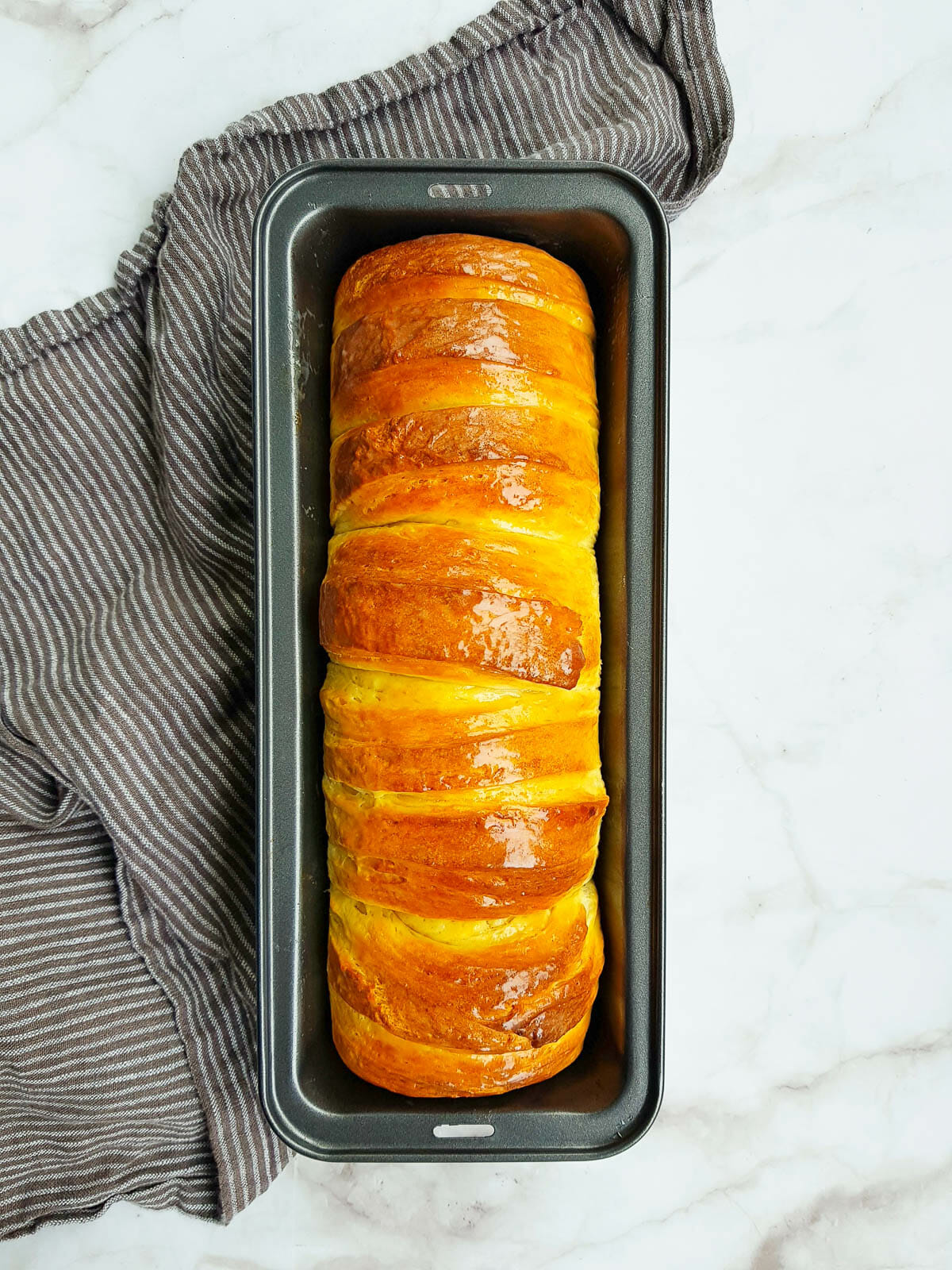
This is my favorite milk bread recipe; it's also one of the most popular recipes on the blog. The recipe received a lot of love and a high rating due to its perfection. It is safe to say this is the best fluffy condensed milk bread recipe, and if you haven't tried it yet, now is the time.
If you're into homemade fluffy yeasted bread, I have a selective collection of many creative dinner rolls/bread for you to try. Such as these butter Parker house rolls, honey dinner rolls, cinnamon raisin braided bread, or caramelized monkey bread, to name a few. If you're into quick bread recipe, try this homemade quick & moist banana bread.
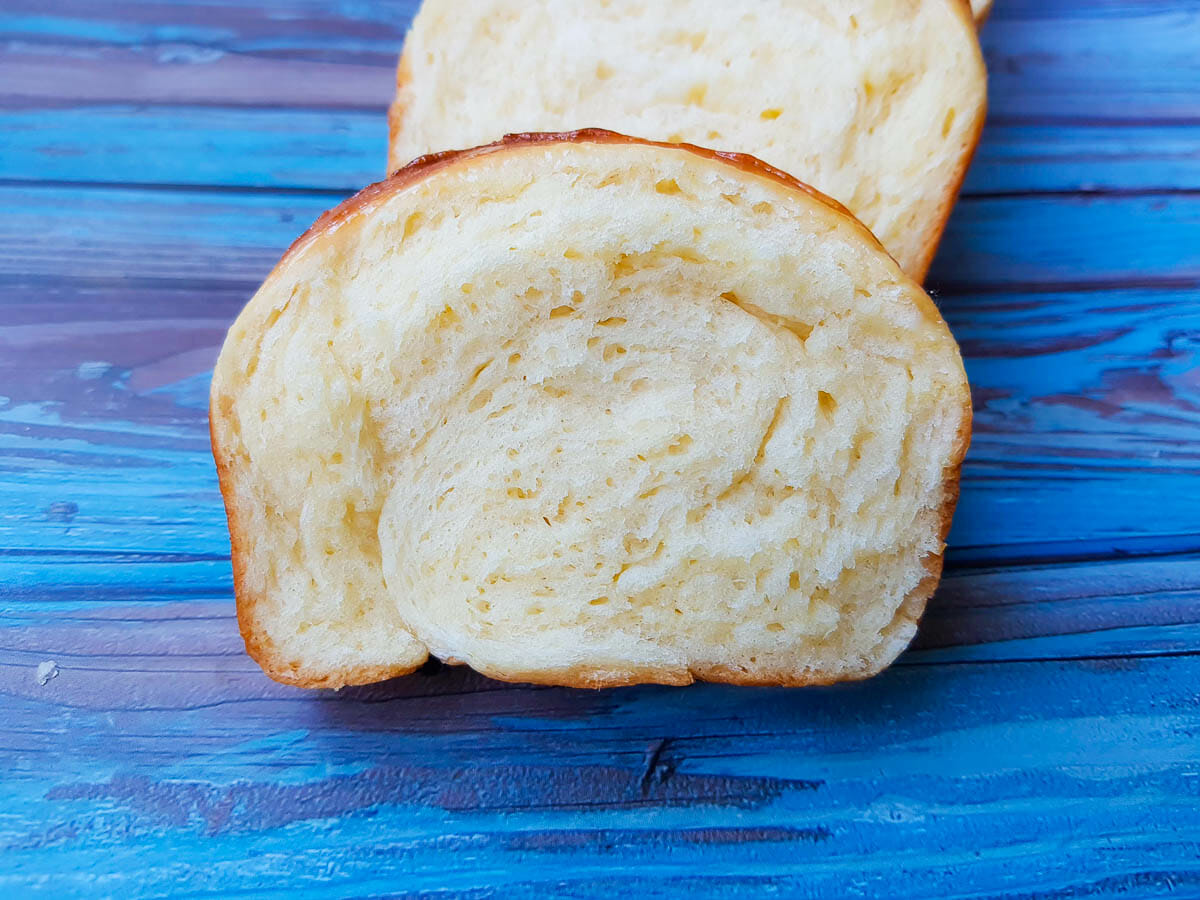
Baking schedule
- 9:00 am - gather ingredients
- 9:10 am - mix and knead ingredients in stand mixer
- 9:15 am - knead the dough by hands
- 9:30 am - first proof
- 11:30 am - shape the dough by hands
- 11:50 am - second proof
- 1:20 pm - bake fluffy condensed milk bread
- 2:00 pm - take out of the oven
- 2:05 pm - add condensed milk glaze
- 2:10 pm - finish
Why you'll love this recipe
- Different: this isn't your usual homemade bread. Lets surprise your friends and family with this 100% successful and unique bread recipe.
- Easy: don't be intimidate by its long process. This sweetened condensed milk bread is easier to make than it looks.
- Attractive: it can't be overstated how delicious and tasty the condensed milk glaze on this fluffy bread.
Essential ingredients
Sweetened condensed milk - the name of the bread reflected its main ingredient. I use ½ cup in the recipe for the needed sweetness. You can reduce it to ⅓ cup if you like a little less sweet.
Cake flour - I always prefer King Arthur flour over other brands when it comes to baking. You can substitute for all purpose flour if cake flour is not available for you.
- Do not use self rising cake flour or bread flour. You can't control the rising with self rising flour while bread flour will yield a much more elastic dough for this supposed to be fluffy and soft milk bread.
- If all purpose flour is used instead, use 2 tablespoons less AP flour per cup of cake flour, and add 2 tablespoons of corn starch per cup.
Whole milk and unsalted butter - all need to be at room temperature before incorporate into the mixture. Because cold milk and butter will reduce the activity of yeast and also not well incorporated.
Instant rise yeast - SAF gold instant yeast should always be your top pick. It is the world’s top selling instant yeast. You can read more about choosing the right type of yeast and how to store yeast here.
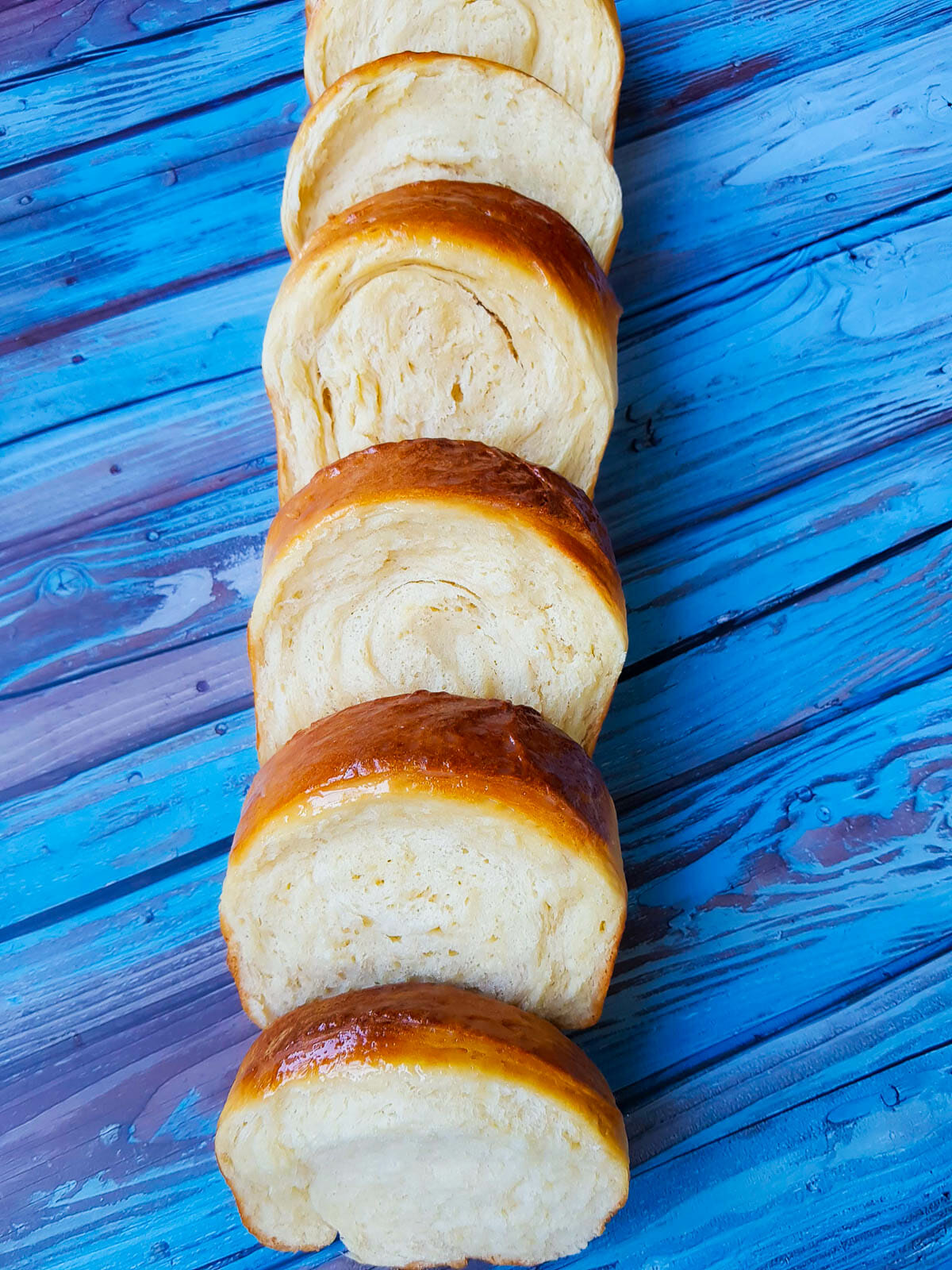
Baking procedure
In order to have the most fluffy texture for this condensed milk bread recipe, the kneading and shaping processes are the most important steps. The same goes for any other bread/dinner rolls recipe or other type of yeast dough (such as kolaches).
The procedure is the same as making dinner rolls recipe or any other bread type recipe:
- Mixing
- Kneading
- First rise
- Shaping
- Second rise
- Baking
- Cooling and storing
How to make fluffy condensed milk bread
1. Mixing
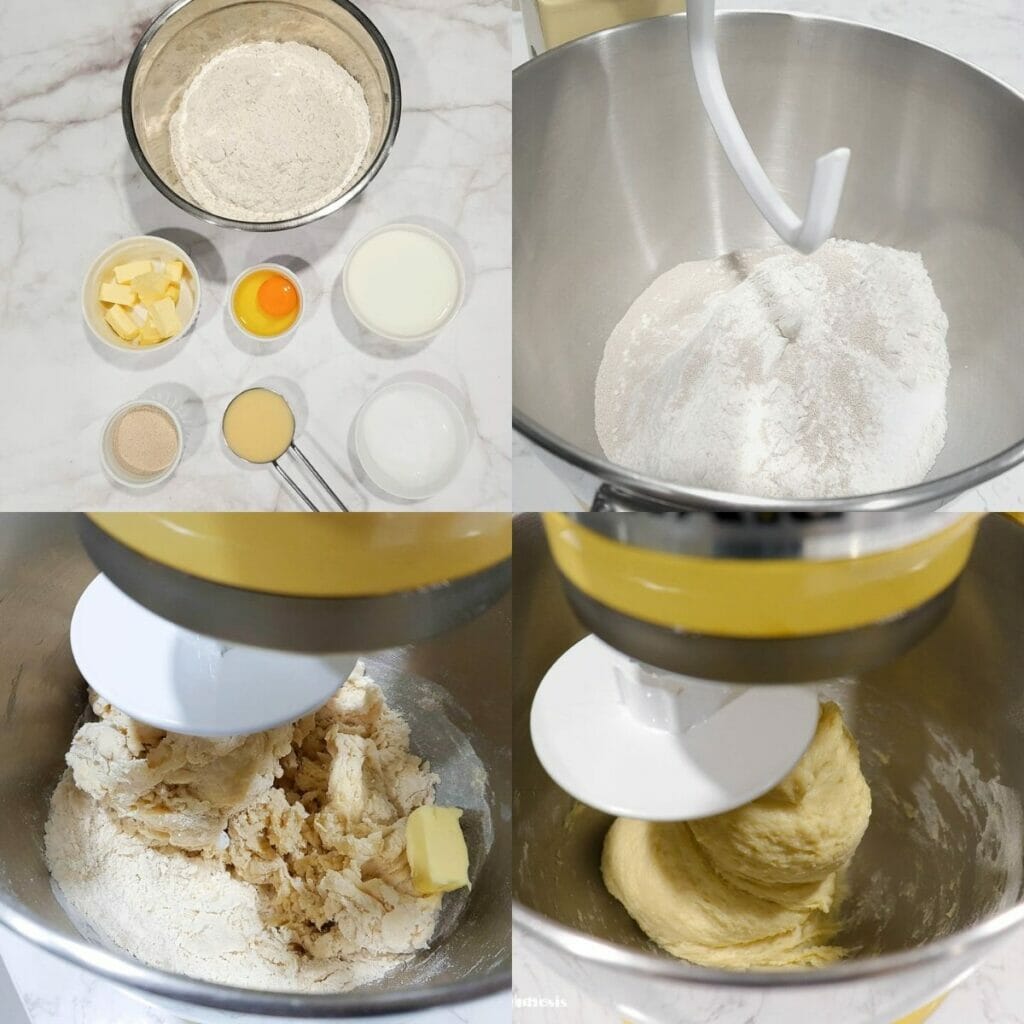
- Gradually add wet ingredients in dry ingredients and mix on low speed with the dough hook attachment.
- Mix until the cohesive dough starts to form, approximately 30 seconds to 1 minute. Use rubber spatula to scrape any flour still sticks on the sides of the bowl if necessary.
- Increase the speed to medium, then add softened butter (at room temperature) one piece at a time. Make sure each piece is fully incorporated before adding the next. Then continue to mix the condensed milk bread dough until it is smooth, elastic and pulls completely from the sides of the bowl.
2 & 3. Kneading & first rise

- Transfer the dough to a lightly floured surface (about 1tbsp of flour is enough).
- Start kneading the milk bread dough by hand to form a rough ball by gentle picking the edge of the dough that's farthest away from you toward the middle. Then gently pressing the dough down and away from you with the heel of your hand.
- Turn the dough 90 degree and repeat the picking and pressing process to fold the dough. Repeat these steps a few times until the dough forms a completely smooth, round ball. Approximately 1 to 2 minutes.
- Put the smooth, round ball of dough (seam side down) in a lightly greased large mixing bowl. Cover tightly and let the dough rise double in size, approximately 1.5 to 2 hours. This proofing time is a standard used for most of yeasted bread/dinner rolls recipe.
4 & 5. Shaping & second rise
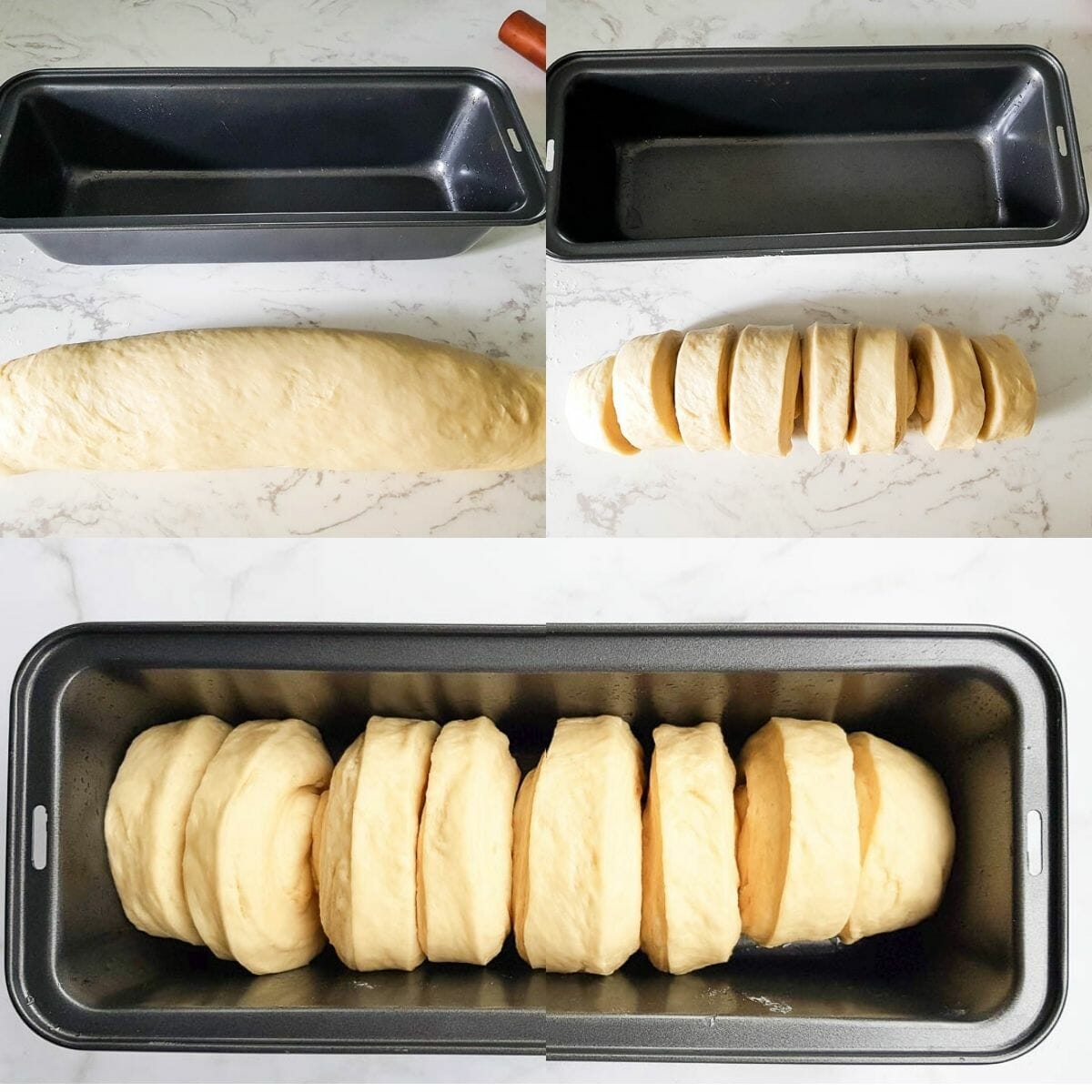
- Firmly pressing the dough into a square or rectangle with your hands and the help of rolling pin. Just make sure the length of the dough is fit within the length of your chosen baking pan.
- Start picking the edge that is closed to you and carefully rolling the dough away from you to a cylinder. Remember to tuck the sides as you go. Then pinch the seam close tightly at the end.
- Use serrated knife or your sharpest knife cut cylinder into pieces with equal thickness.
- Then arrange the dough neatly, seam side dough in a lightly greased baking pan. Cover loosely with plastic wrap and let the dough rise almost double in size again, approximately 1 to 1.5 hours.
6. Baking
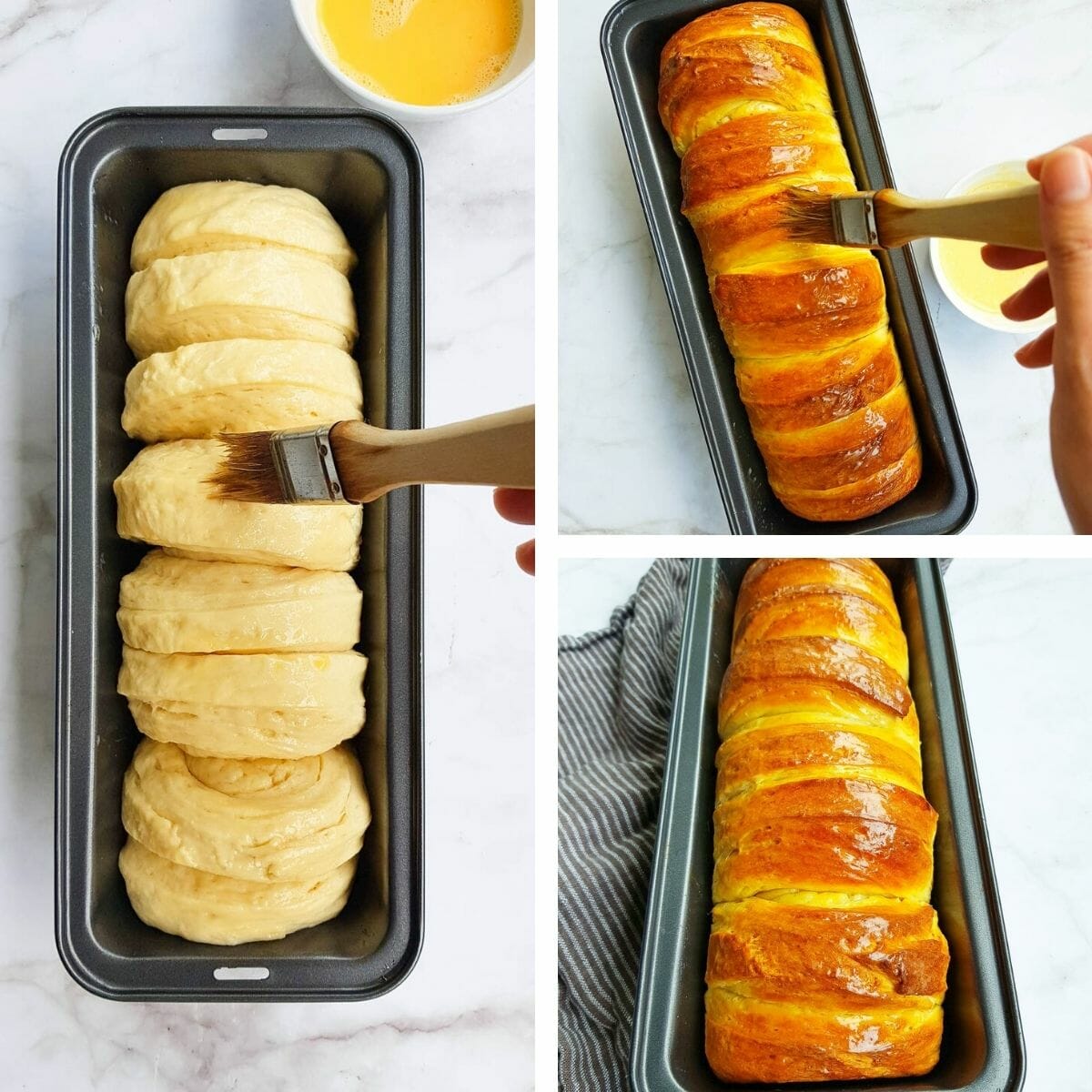
- Before baking, lightly brush the top of the already proofed dough with egg wash mixture.
- This fluffy condensed milk bread/dinner rolls recipe must be baked at 350F for 35 to 40 minutes. Remember to turn the baking pan halfway through the process.
- When the bread is done, lightly brush it with condensed milk glaze when the bread is just freshly out of the oven.
7. Cooling and storing
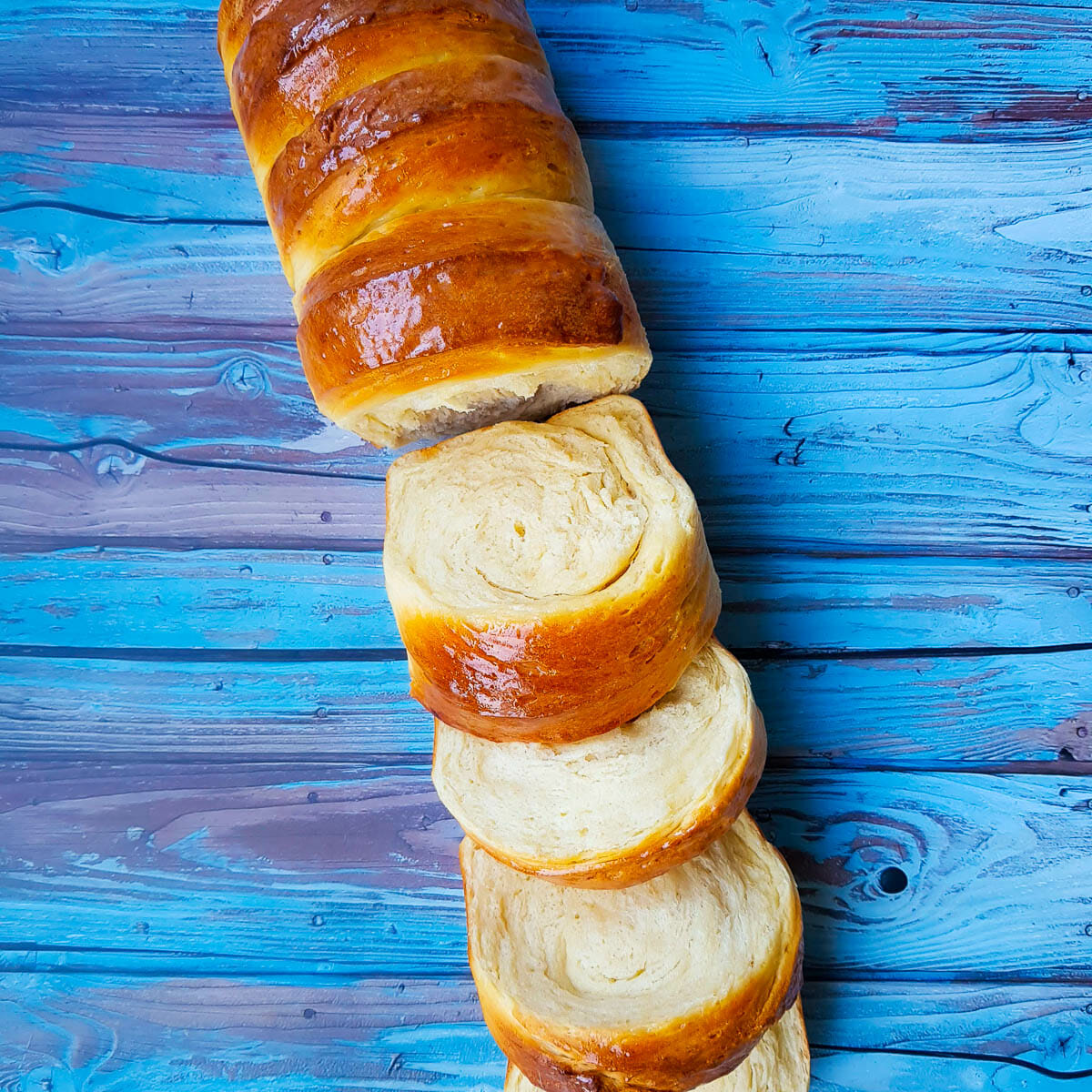
- Carefully unmold the bread.
- Allow fluffy condensed milk bread to cool down on a wire rack.
- This sweetened condensed milk bread or any other enriched bread/dinner rolls can be wrapped in plastic and stored in a cool, dry place at room temperature for up to 3 days.
Can I freeze this bread?
Definitely. You can freeze this milk bread using these instructions to preserve its freshness and texture.
- Make sure the bread is cool down completely.
- Tightly wrap condensed milk bread in plastic wrap (recommend two layers for max protection).
- Put in the freezer. The bread can be kept for up to 2 months.
- It's better to freeze bread slices than a whole loaf.
- When ready to serve, unwrap and put the bread on a wire rack to thaw in the refrigerator or at room temperature.
- Do not re-freeze the bread.
What to do with left-over milk bread?
Left-over, unused milk bread is a perfect fit for this bread pudding. Use this amazing raisin bread pudding to transform it, once again, into excellent baking good.
Can I mix this condensed milk bread by hands?
If you don't have a mixer, you can definitely mix this bread dough by hands following these instructions:
- Since this is a rich dough and somewhat sticky, you must grease the mixing bowl with either vegetable oil (~1-2 tsp) or flour. The spatula needs to be greased as well. Also, it's better to use melted butter instead of softening butter in this case.
- Make sure melted is calm and not piping hot while incorporating dry ingredients.
- After adding wet ingredients to dry ingredients, use a spatula to mix everything.
- Fold the dough by gently lifting and folding the edge towards the middle. Then turn the bowl 45 degrees and fold the edge toward the middle again. Repeat this turn & fold process until everything is well incorporated.
- The photos for these lifting and folding steps can be found in Ciabatta bread recipe. It takes around 10-13 minutes if mixed by hands.
- After that, cover the mixing bowl with plastic and let the dough rest for 10 minutes before proceeding to steps 2 & 3.
Did you make this recipe? If so please leave a rating and let me know how it went in the comment section. Also, don't forget to tag me #cookmorphosis @cookmorphosis on social media.
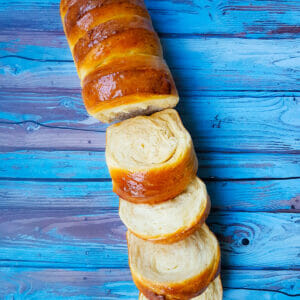
Fluffy condensed milk bread
Ingredients
Bread dough
- 3.5 c cake flour see notes for AP flour substitution
- 1 tbsp instant yeast
- ½ tsp salt
- 1 c whole milk room temperature
- ½ c sweetened condensed milk
- 1 medium egg
- 2 oz unsalted butter softened, at room temperature, cut into pieces
Egg wash
- 1 medium egg
- 1 tbsp whole milk
Condensed milk glaze
- 3 tbsp sweetened condensed milk
- 1 tbsp unsalted butter softened, at room temperature
Instructions
Mixing & kneading by mixer
- Combine all dry ingredients (flour, yeast, salt) in a mixing bowl of a stand mixer fitted with a dough hook.
- On slow speed, add wet ingredients (milk, condensed milk, egg) to dry ingredients and mix until cohesive dough starts to form—approximately 30 seconds to 1 minute. Use a rubber spatula to scrape any flour that sticks on the bowl's sides if necessary.
- Increase the speed to medium, then add softened butter one piece at a time. Make sure each piece is fully incorporated before adding the next. Then continue to mix the dough until it is smooth, elastic, and pulls entirely from the sides of the bowl.
Extra kneading by hands
- Transfer the dough to a lightly floured surface (about 1tbsp is enough). Start kneading the dough by hand to form a rough ball by gently picking the edge of the dough that’s farthest away from you toward the middle. Then gently press the dough down and away from you with the heel of your hand.
- Turn the dough 90 degrees and repeat the picking and pressing process to fold the dough. Repeat these steps a few times until the dough forms a smooth, round ball. Approximately 1 to 2 minutes. You can lightly sprinkle the dough with flour as needed along the way if the dough becomes a little bit sticky.
First proof
- Put the smooth, round ball of dough (seam side down) in a lightly greased large mixing bowl. Cover tightly and let the dough double in size, approximately 1.5 to 2 hours. This proofing time is a standard for most bread/dinner rolls recipes.
Shaping
- Punch the dough to deflate, then transfer it to a lightly floured surface.
- Firmly press the dough into a square or rectangle with your hands and with the help of a rolling pin. Make sure the dough's length fits within the size of your chosen baking pan.
- Start by picking the edge that is closed to you and carefully rolling the dough away from you to a cylinder. Remember to tuck the sides as you go. Then pinch the seam close tightly at the end.
- Use a serrated knife or your sharpest knife to cut the cylinder into pieces with equal thickness.
Second proof
- Arrange the dough neatly, and seam side dough in a lightly greased baking pan. Cover loosely with plastic wrap and let the dough rise almost double in size again, approximately 1 to 1.5 hours.
Baking
- Pre heat oven to 350F.
- Lightly brush the top of the already-proofed dough with an egg wash mixture.
- Bake for 35 to 40 minutes. Remember to turn the baking pan halfway through the process.
- When the bread is done, lightly brush it with condensed milk glaze when the bread is just freshly out of the oven.
- Finally, let the bread cool down to room temperature completely before serving.
Notes
- If you need to use AP flour instead of cake flour, use 2 tablespoons less AP flour per cup of cake flour, and add 2 tablespoons of corn starch per cup.
- This milk bread or any other enriched bread/dinner rolls can be wrapped in plastic wrap and store in a cool, dry place at room temperature for up to 3 days.
- See above for freezing tips.
- Left-over, unused milk bread is a perfect fit for this bread pudding. Use this amazing raisin bread pudding if you want to transform it once again into a wonderful dessert.
Nutrition
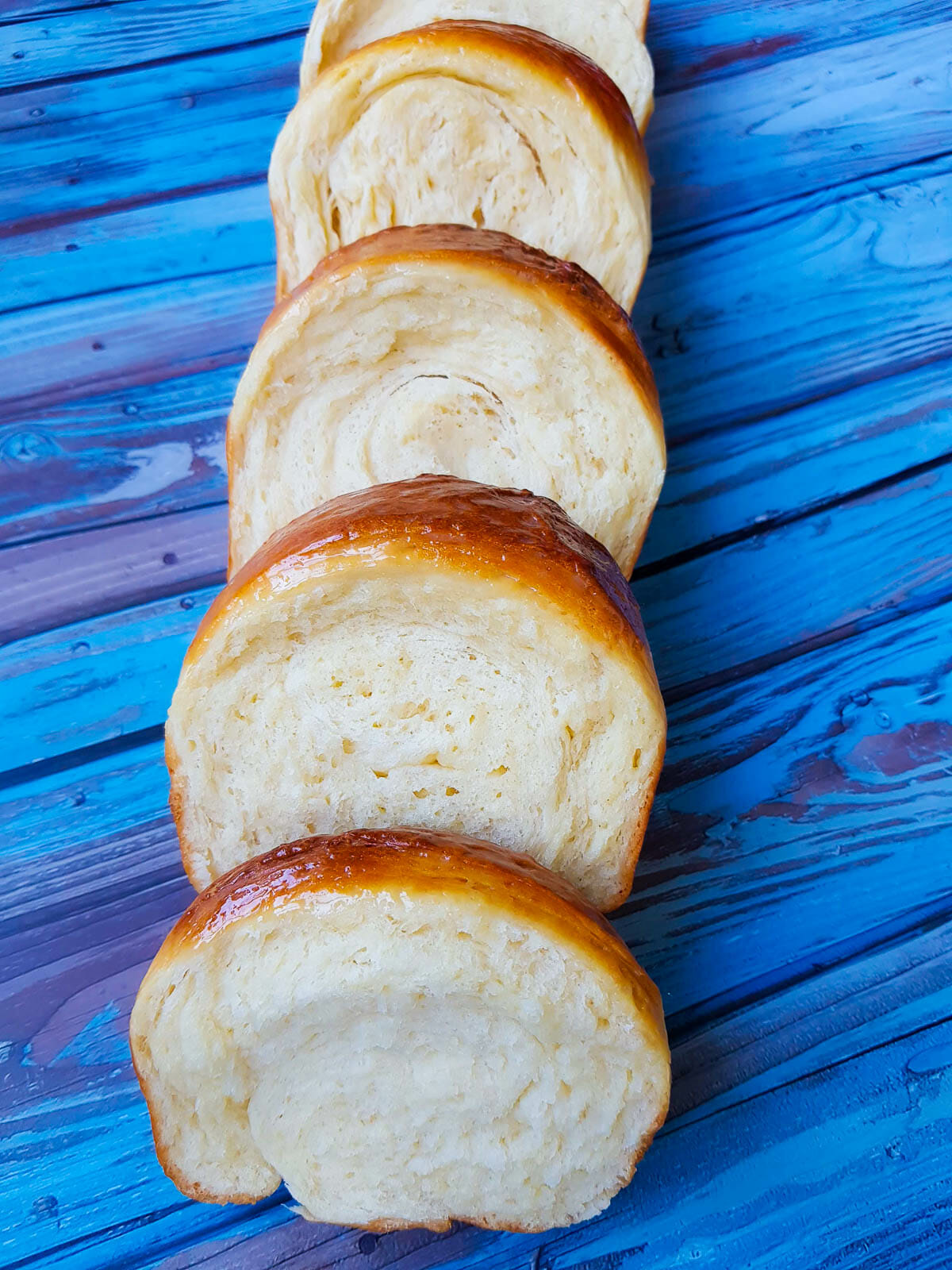
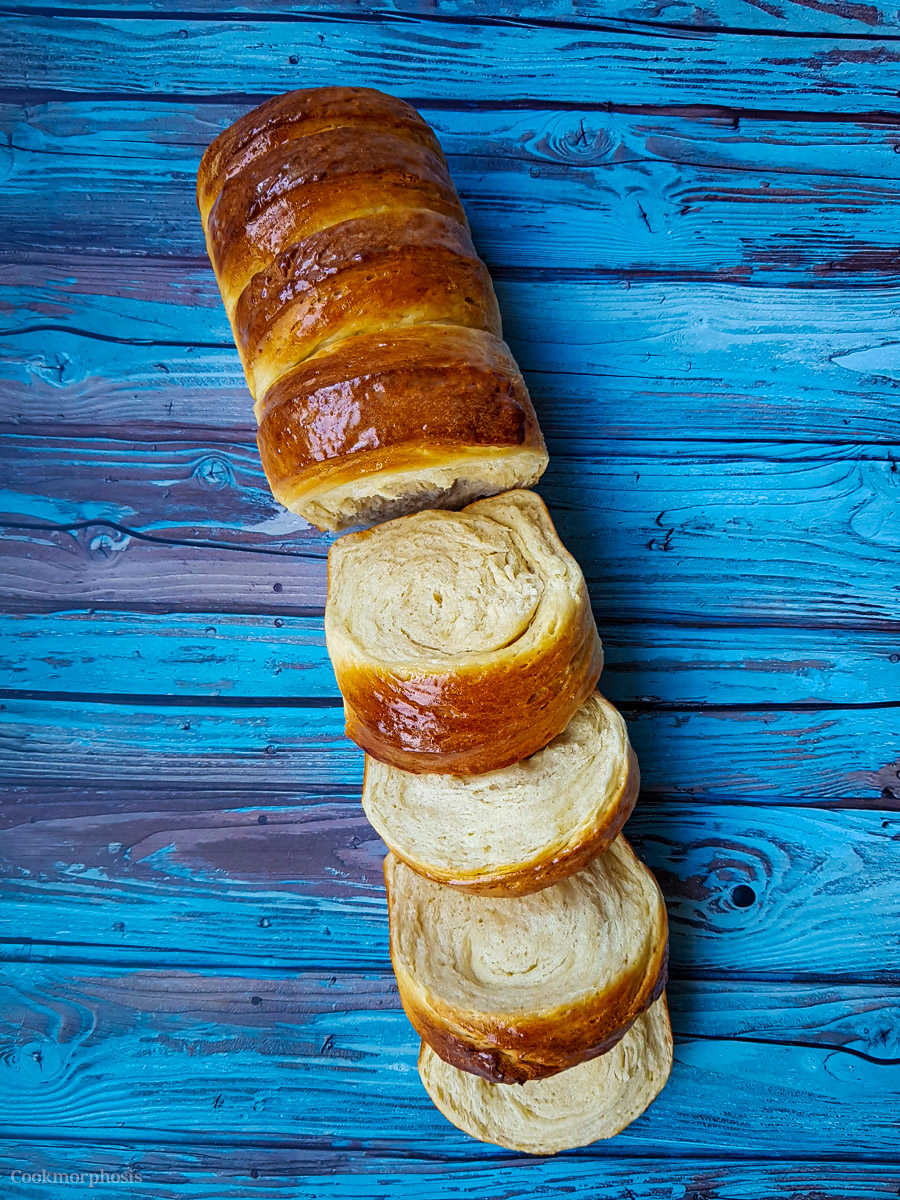
Did you make this recipe? If so please leave a rating and let me know how it went in the comment section. Also, don't forget to tag me #cookmorphosis @cookmorphosis on social media.

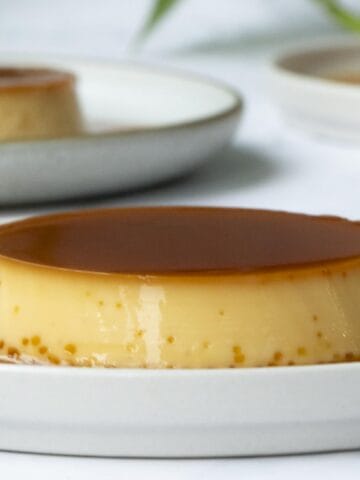
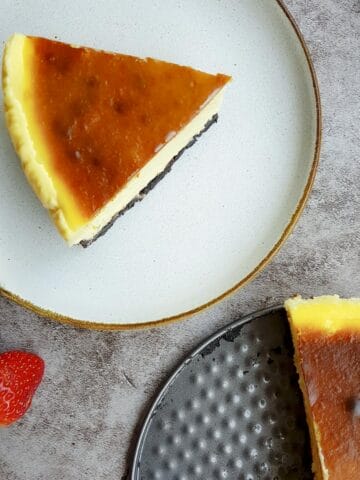
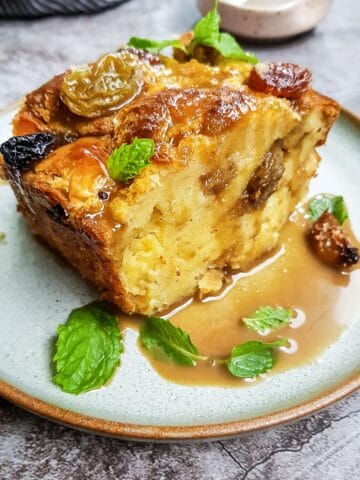
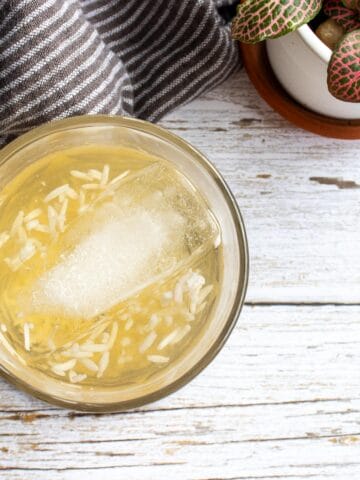
I am pretty new to baking bread, i tried this and did exactly what you put down, i used AP flour though and no corn starch. It is on the second proof now, fingers crossed it comes out amazing and delicious!! Thank you for this recipe!!!
Thank you for give it a try. If you can, please let me know how it turned out (good or bad). I really appreciate your time.
What a waste. I made 6 loaves. I should’ve known better about the yeast as I bake a lot. The dough never did rise much because it didn’t activate. All that time and money just to throw all 6 loaves in the trash!!!!! 😡😡😡😡😡
Hi Terry,
It was unfortunate the recipe did not work out for you. Did you use active rise yeast or instant rise yeast? And how was the temperature in your area right now? That might affect the rise of this bread too.
This recipe was easy and fast I love it
Hi Stephanie,
Thank you so much for the feedback. I am so glad that the recipe worked out perfectly for you.
I made this today but I think I’m the one that made the mistake because I tried to cut it in half. I didn’t roll it. I did roll it up but I didn’t cut it in individual sections. I just put it in the pan it’s not light and fluffy.
I’m a little confused about the proofing with instant yeast. I thought the purpose of instant yeast was to only proof once, and for a very short time. Does instant yeast work when timed like regular active dry yeast? If so, could active dry yeast be substituted in this recipe?
Using instant yeast, you can mix it directly into the dough. While using active dry yeast, you must activate it with warm water first, then proceed. And yes, you can substitute for active yeast with the same amount.
Made this yesterday. I was intimidated by the long explanation and notes but it came out fantastic! Wish I took pictures I could've sold this at a high end bakery lol. Thanks so much my 4 boys went crazy for it.
Hi Dani,
Thank you so much. I am so happy that your family loved the bread.
Hi Tu
Made this again today exactly the same but this time the outside burned at 30 min. Any idea what could've changed. The only thing different is I used AP flour.
I don't think AP flour caused the problem. The only thing I could think of is it had something to do with the oven temperature and the position of the rack. Did you leave it in the middle or highest rack? Or did you set the same setting for the oven?
That's not true. I use active dry yeast in my sourdough sandwich bread all the time, and I never put it in warm water before putting it in my dough.
Hi Rosetta,
Agree to disagree. Active dry yeast needs to be activated with warm water to fully work its magic. Maybe next time you try this and see the difference?
Can I just make half a loaf? Can I freeze the dough, if so how.
Honestly it's worth it to make the whole thing because it doesn't last. I divided it into 2 loaves, cooked it the same as stated on recipe and they came out amazing. The first loaf lasted a maximum of 5 minutes on the counter once my kids saw it. And the second was barely enough for my husband and I
This is a beautiful recipe! My husband loves homemade bread. I found this so easy to knead. I turned out beautiful and delicious. My only complaint is that he ate it all and wants more, like now. Thanks so much
Hi Mindy,
OMG, I feel over the moon for this. Thank you so much for trying the recipe out, and loving it. It means so much to me :).
Could this bread be used for cinnamon rolls?
Hi Paulette,
Yes, it could. You might want to cut the recipe in half for cinnamon rolls. Let me know how it goes :).
Thank you so much for sharing this recipe. Your instructions are spot on. I also enjoy the special tips. My granddaughter's doing farmers market and I'm the baker. I found your recipe just had to try it it sounded so interesting. It's everything you claimed it was and more nice crust fluffy on the inside. I'll let you know how it goes at the Farmers market.
Hi Julie,
Please let me know how it goes. Can't wait and supe excited. And thank you so much for trying the recipe, it means a lot to me.
Oh wow, this is delicious bread, the closest thing to Hawaiian Sweet Bread I have made and will be making it again very soon. I used my stand mixer and followed your directions closely. I don't have a big loaf pan so I divided the dough in half and made two (2) 1 lb. loaves. The only other thing is the glaze, while it adds a nice sweetness, it's a sticky mess that never sets making bag storage an issue. I seriously doubt I will be using the glaze again.The big pull apart slices make perfect pocket bread to stuff with chicken, tuna, salmon or ham salad for a great lunch plate. Thank you Tu this recipe is a keeper for sure.
Hi Gail,
Thank you so much for the compliment. I feel so flattered. About the glaze, you are right. It can be a mess sometimes. Another option is serving it as a dipping sauce on the side. Also, I love the idea of stuffing it with chicken/tuna/ham; gotta put this on my testing recipes list soon.
I have officially made this recipe in a bread maker and a loaf pan and I can honestly say, it’s day and night. I don’t know what it is about the loaf pan, but it always produces a light, fluffy wonderful soft bread. The bread maker was basically pound cake with a huge crust 😂
Hi Rachel,
Thank you so much for the feedback; I'm so glad the recipe works ideally using the bread maker. This urges me to buy one and try it so badly :).
Unfortunately I ran into the same issue as another person who commented about the dough being too wet and not becoming cohesive in the mixer. I think this recipe might benefit from also listing the weight of the ingredients for bakers who prefer to measure ingredients with a scale. This might help eliminate the inconsistent results. And although times may vary in a mixer, it would be helpful to give a general (even if wide estimate) of how long it might take. I was afraid to overmix, but never really knew how long it could actually remain in the mixer. I didn't want to add too much flour for fear that it would also make the dough too dense. I ended up putting a wet, shaggy dough in a loaf plan for the 2nd rise, but we'll see how it turns out.
Hi JL,
This is an enriched dough (as mentioned many times in the post), so you might find it wetter and softer than other bread doughs. If you find it too soft to handle, you can excessively flour the working counter and your hands while hand kneading and shaping the dough.
I totally agree with you on the weight thing, it's the most consistent way to bake a loaf of bread (or anything else). But as for many of readers, using volume measurement (cups & spoons) is more convenient for their busy schedules. That is why you find only cups and tbsp measurement here (for now). I'll update the ingredients measurement in weight very soon, and hopefully, you will decide to give the bread a try one more time.
Thanks a lot for your feedback, i really appreciate them.
Thank you. I think one additional note is perhaps suggested baking size pans?
I used a pretty odd pan: 11.5 x 4.5 x 2.5 inches. The reason it was not mentioned in the recipe is that you can freely shape the bread to fit into your choice of pan. But yes, it is a good idea to put this information into the recipe card for more references. Thank you so much for the insights, I for sure have overlooked them.
I'm curious what you think about using this recipe to make bread that's not in a loaf--maybe rolling the dough into balls and baking on a baking sheet? Or baking it in a muffin pan?
Hi Chad,
You definitely can bake these as dinner rolls or separate rolls. If you decided to bake these as dinner rolls in an 8x8 inch cake pan, it would take the same amount of time (35-40 minutes @ 350F). If you wanted to bake these as separate rolls on a baking sheet, it would take a shorter time to finish (20-25 minutes @ 350F). I also would scale each ball around 2~2.2oz dough. I haven't baked these in a muffin pan yet, and I would recommend not to do so because of their expansion during the baking process.
You can check these recipes for more references about what I was explaining: https://cookmorphosis.com/butter-parker-house-rolls-supper-fluffy-recipe/ and this https://cookmorphosis.com/fluffy-milk-dinner-rolls-better-than-store-bought/.
Please come back and let me know how the customization comes out :). I can't wait.
I would like to make this bread, but I do not have a mixer...It will all be done by hand. How long should I knead the dough?
Hi Ellen,
You can put all the ingredients in a large mixing bowl and use a spatula to fold/mix everything together. Here are the guidelines if you decide to make this bread by hands. Since this is a rich dough and somewhat sticky, you need to grease the mixing bowl with either vegetable oil (~1-2 tsp) or flour. The spatula needs to be greased as well. Also, instead of soften butter, it's better to use melted butter in this case.
After adding wet ingredients to dry ingredients, use a spatula to mix everything together. Then you need to fold the dough by gently lifting and folding the edge towards the middle. Then turn the bowl 45 degrees and fold the edge toward the middle again. Repeat this turn & fold process until everything is well incorporated (I have photos in Ciabata recipe that carefully demonstrate this process; you can search for Ciabata on my site for more references). I would estimate it takes around 10-13 minutes by doing so.
After that cover the mixing bowl with plastic and let the dough rest for 10 minutes
before proceeding to "extra kneading by hands" step. There is nothing change for rest of the process.
Last but not least, definitely let me know how it goes. I'm looking forward to it. And if you still have any question, feel free to pop back in and ask anytime. I'm here to help.
May I ask if this beautiful recipe can be made in a bread machine?
Hi Debra,
You definitely can. Though I never used bread machine for this bread, one reader has successfully made it. You might want to cut the recipe in half or so in order to fit the machine. Please let me know how it goes.
I used my aksarben bread mixer. And rose it as required. Baked for 35 minutes. My bread came out dry and crumbly. I will try again
Hi Lynda,
So sorry to hear that! Definitely let me know how it goes the next time you try. I haven't tried the recipe using bread machine yet, but i'll try to troubleshoot for you as much as I could if you could gimme me more details about the process :).
Mine also came out dry
Hi Sandi,
Sorry to hear that. I understand the recipe wouldn't work for everybody. It's a hit or miss once in a while. Thank you so much for trying out the recipe anyway. If you ever decide to give it another try, please let me know how the second time turns out.
Can I make the dough the day before? If yes, how this process goes?
Hi Lisa,
Yes, you can definitely make the dough ahead. So you will do 'the First proof' step under refrigeration. After 'Extra kneading by hands' step, move the round ball to a mixing bowl then cover bowl tightly with plastic wrap and refrigerate for up to 24 hours.
When you take the dough out of the fridge, proceed with 'Shaping' step and follow the rest of the recipe.
Hope this helps. Let me know how it goes :).
It's 8am in Australia, I made this dough yesterday despite an obstacle of three curious and energetic children.
I have no mixer so I made it by hand, I don't have measuring cups also but I have used the same measuring techniques my whole life lol it rested overnight on my counter top, obviously cling wrapped. I slept soundly but even in my dreams anticipation buzzed at my finger tips.
I've just put the loaf in the oven, seen the big kids off to school and sat down to nurse my baby, I can smell the sweet bread cooking in our oven. Soon you will be mine.
Last I checked it had risen beautifully, formed a caramel coloured crust on top and smelled incredible. It's resting now. Waiting for me.
I'll have to update you once I try it, I'm taking it to Nana's for her birthday lunch today.
Hi Ruby,
That sounds very anticipated. Please do let me know how you like the loaf. I can't wait and hope it turned out perfectly for you :).
What size loaf pan did you use?
Hi April,
I used a pretty odd pan: 11.5 x 4.5 x 2.5 inches.
I am making this bread right now but it would not pull away from the sides of the bowl until I added several additional tablespoons of flour. Could that be because I am in a cold, dry climate? I am afraid it is going to turn our chewy now because of the excess kneading time and excess flour.
Hi Kristen,
You're correct. The weather could have an impact on the dough as well. Since you've already added extra flour into the dough, you should try to use less flour when kneading it by hand. And let the dough rest (covered mixing bowl with plastic wrap or a damp towel) few minutes before proceed further too. Hope this helps :). Let me know how it goes.
I made this loaf today and it turned out really fluffy, soft and delicious. I Didn’t change anything except maybe the kneading time. I did knead a bit longer than 2 min….more like 5. I liked the subtle sweetness. I wonder if I can add dried fruit to it and use for something like hot cross buns? I will definitely be making this loaf again and use for rolls as well.
Hi Wendy,
I am so glad that the recipe turned out perfectly for you. You can definitely add dried fruit (such as dried cranberry or raisin). Here is what I recommend: right after finished mixing all soften butter (step 3 - Mixing & kneading by mixer process), reduce the speed to low then slowly add dried fruit and mix until well incorporated, about 2-3 minutes.
Please definitely let me know how your fruity cross bun turn out. I'm looking forward to it.
I made another loaf today and incorporated sultanas …my husband loved it! It turned out so nice…thank you for sharing your recipe with us! I will use it next time for cinnamon bun rolls!
Thank you so much for letting me know the result. It is my absolute pleasure that you and your husband love the loaf :). Cinnamon bun rolls sound so awesome.
I wrote a response earlier but I’m not sure if it went through?
Hi Lucy,
Yeah, your comment went through. Sorry about the wait. I still manually approve all comments to prevent as many spam ones as possible so sometimes it'll take awhile to go through. My apology :).
Could using melted butter cause my dough to rise?
Hi Rachel,
You can use melted butter, it won't affect much with the bread rising process. But it might affect the bread structure due to a very wet dough. The original dough (which using soften butter) is already rich and lightly wet. So my recommendation is if you want to use melted butter, you can incorporate it with all purpose flour instead of cake flour. Because AP flour has more protein which will become gluten afterward, it helps to hold the structure of a very wet dough better. Hope this helps.
Please let me know how the bread turns out (either you use AP flour or cake flour), I would love to hear about the result.
It tasted pretty good but still a little dense and not as fluffy as I’d like it to be. I baked it for 38 mins, I’m wondering if I baked it too long or maybe I didn’t knead it enough? I allowed it rise for 1.5 hrs both times and used ap flour and did the corn starch substitute. Can you give me some pointers of I could’ve done better?
Hi Lucy,
Thank you so much for trying the recipe. Here are some pointers I could think of that can help to make the bread more fluffy:
1. When kneading the dough, try to use less additional AP flour as much as possible. I understand that this is a rich dough and sometimes that causes the dough stick to our hands while kneading; so we often coat our hands with too much needed flour. Too much add-on flour can be one of the reasons as why the bread turns out too dense.
2. You are right about the kneading and baking time. Maybe give the dough an extra couple minutes of kneading them. Since all ovens are different, try to give the bread 2-5 more extra minutes for the baking process. Also, every time you open the oven door, the heat escapes and the oven temperature drops. It'll take awhile for it to come back to desire temperature so try to resist open the door.
3. I know I mentioned in the recipe in first step: combine all dry ingredients but I forgot to mention (thanks for your question, I'll update the tips for the recipe soon) that salt can kill yeast which may cause the bread become dense. So when mixing them together, try not to put yeast and salt on top of each other or have direct contact with one another.
Hope these help. And please let me know if you still need more tips. I'm here to help.
Hi there I only have bread flour this time can I still use it? If so, any suggestions to help get it fluffy
Question 🙋♀️
Are you talking about “evaporated milk”
or “sweetened condensed milk”?
Hi Sarah,
It's sweetened condensed milk :).
I’ve made this and it’s delicious! Just wondering if I can use this recipe to make cinnamon.rolls?
Hi Michelle,
You definitely can use this recipe for cinnamon roll. You may want to reduce the amount of sugar in either fillings or glaze because this dough is already rich. Other than that, everything seems fine to me. Let me know how it turns out :).
So I made it to the T. I’m sure I will never get back my wasted day. It turned out dense, it tasted fermented and the texture was dense complete opposite of fluffy. Terrible recipe.
Hi Ruth,
I'm sorry to hear that the bread turned out so dense for you. As you can see many others have successfully made the bread fluffy based on the recipe. There are many other factors can interfere with the baking process so I am happy to trouble shoot it for you.
By judging the end result of the bread which was dense and smelled fermented, I can say it was over-proofed. So if you wanna give it another try and shorten the fermented time, I bet it will taste and feel much better. I hope you give the recipe another trial. Hope to hear from you soon.
1. Is it possible to use just sugar than condensed milk and how much?
2. Can I reduce the yeast to 1/2 tbsp?
3. Can I apply some butter and add raisin, red beam paste or chocolate before roll up?
Thanks
Hi Sia,
1. Though I haven't tried to substitute sugar for condensed milk, I think you absolutely can. Try to add 1/3 or 1/4 cup of granulated sugar and 2~3tbsp of milk. Try to add the milk gradually, like 1 tbsp at a time so you won't over wet the batter.
2. Yes, you can. It'll take longer time for the dough to rise though.
3. Yes, you definitely can add raisin/red bean paste/choco to the bread dough during the shaping process. Because this is a rich dough and has a wet texture, you might not need that extra add-on butter thou. I also have a raisin bread recipe that you can check it out if you want: https://cookmorphosis.com/soft-cinnamon-raisin-bread-how-to-make-it-from-scratch/
Let me know if you still have any more questions. I'm happy to help.
I love this recipe I've tried it 3 times and I love it, my loafs look, taste great every time. I'm putting one in the oven right now, hubby loves too. Thank-you for sharing
Hi Susan,
Welcome back and thank you, thank you so much for loving the bread. I'm over the moon and the stars right now.
Is this bread anything like Hawaiian bread? And can it be made in a bread machine?
Hi Candie,
This can be used as the closest homemade version of Hawaiian bread. It is soft, moist, fluffy and sticky on top just like the famous Hawaiian one.
Furthermore, I myself haven't used the recipe for bread machine but I think it's gonna be just fine. Let me know how it'd go if you ever decided to make the recipe using bread machine. I'm very curious :).
I tried this recipe and I love it ,my loaf turned out so pretty and tasty. I've tried other milk bread recipes but this is my favorite so far Thank-you for sharing.
Hi Susan,
I'm so happy that you love the recipe and the bread turned out perfectly for you :). Thank you for trying it out and letting me know how you love it. It meant a lot to me.
Hi Tu!
I've made this bread a few times and it has been PERFECT every time...and so yummy! I have to change the measurements to metric...those American 'cups' are hard to follow...but for anyone else who wants to use metric...it's 420 gr flour..240 ml milk and 120 ml condensed..
Best wishes from Ireland!
Hi Ger,
That is super awesome to hear. Thank you so so much for trying out the recipe and also adding the measurement in metrics, I really appreciate that!
Ger - you’re a hero! I can’t get my head around ‘cup’ measurements & wet & dry measurements aren’t the same 😵💫🤯The conversion charts look like complex quantum physics & my will to bake just disappears.
Now I can try this recipe with ease. Thank you so much!
Just made this today, it came out perfect! And it was delicious! So happy I tried it. I used all purpose flour and followed the directions. It looks just like the picture! We had a piece hot out for the oven with butter. YUM!
Hi Karen,
Thank you so so much for trying out the recipe and taking your time to come back and rate it. I am so thrilled that it worked out perfectly for you. And yes, this bread and butter are perfect companion to one another.
I tried this recipe and it's a keeper! I did have to make some adjustments, due to what ingredients I had on hand. I didn't have quite enough corn starch to fully substitute for the regular flour. I also pre-mixed the yeast with warmed milk to "proof" it. While the finished loaf did not look as "fluffy" as I expected, the bread was still light and had a nice bit of sweetness to it. It was great toasted with orange marmalade the next morning. Thanks for the recipe and instructions.
Hi Susan,
Thank you so much for trying out and letting me know how it turned out :). I also have a sister-recipe to this milk bread which uses 100% AP flour, I bet you will love it also: https://cookmorphosis.com/fluffy-milk-dinner-rolls-better-than-store-bought/
If you have time to check it out, you won't be disappointed.
Just because a picture of food is popular on Pintrest it doesn’t mean the recipe is good. It just means people liked the appearance.
At the end of it all the bread was heavy, not fluffy, and the taste was ‘meh’ bordering on ‘throw it out’. I’ve made dozens of milk bread loaves in the past and this reminded me of my very first attempt years ago – except it wasn’t a skill issue this time.
I’ll go back to my other milk bread recipes that I’ve had consistent success with.
Hi,
Thank you for trying out the recipe. And its unfortunate you don't like the taste nor being able to get the right texture. We all have different references for milk bread I bet :). As for the recipe, I believe the photo is just one of the factors makes it popular. I carefully tested and took notes and wrote down detailed instructions for every single recipe that got uploaded to my blog. So it is not something I just randomly took pictures and uploaded for fun because I know my readers will try the recipe out one way or another. However, I understand that what works for me doesn't mean it will work for everybody and vice versa. I value your opinion and you effort giving the recipe a try. As if you could give me a little bit details about how you did the bread, I could help to troubleshoot what could've gone wrong.
Finally, even though you did not like the recipe, you can see there are many of others love the recipe and how the outcome turned out for them (both on Pinterest and on my blog).
When I found this recipe, I was curious ~ what was meant by "condensed milk"?
Was that the same as evaporated milk? Or did the author mean "sweetened condensed milk"?
After reading through the recipe and comments, I figured it was sweetened condensed milk. Perhaps the "no" commenter logically used evaporated milk?
You claim you "wrote down detailed instructions", but this is one detail you missed ;^)
Hi Diane,
Thank you so much for your input, I really value it. Of all my cooking life I've always used condensed milk in terms of sweetened condensed milk. You brought up a very good point. I definitely put it in my note books for future references. Besides this, I hope you like the recipe and it works out perfectly for you. Let me know if possible. Thanks again.
Can u use a bread machine for kneading?
Hi Julie,
Though I never used one, I don't think why not. Just don't over knead the dough thus it can become chewy and elastic. Please, let me know how it goes :).
This recipe for Cindy milk bread looks great. I’m on a keto diet and was wondering if the cake our and milk can be substituted for almond flour and almond milk. Please advise and thank you.
Karen Fahrenbruch
Hi Karen,
Though keto diet is not my main focus for my blog, I did a little research and you can definitely substitute almond flour in this recipe: just use the the exact amount of 3.5 cups in the recipe.
As for the whole milk, you can use the exact same amount too which is 1 cup of almond milk.
For condensed milk, it's a little tricky for keto diet. I found this keto friendly syrup which can be used instead of condensed milk: https://thebigmansworld.com/keto-maple-syrup/.
Hope you find these information useful.
I hope I'm not too late to answer your question, but I always use my bread machine. It turns out perfect every time.
Hi Shelia,
Thank you so much for letting us know this works perfectly fine with bread machine. Also, thanks for trying out the recipe :).
Giving the bread now...it doesn’t seem to be pulling away from the bowl after incorporating the butter...how long does this normally take? I am about 5 minutes.
Hi Kellie,
Give it couple more of minutes or as soon as you check and make sure all of the butters are incorporated completely, it should be fine. The dough is lightly wet though because it is enriched dough. It'll also depend on your kitchen temperature, if it is slightly warm, it'll take a while more for the dough comes together.
I used sweetened condensed milk to market mine. I found it to be fluffy and tastey! No fail here!!! Family and friends loved it too! Thank you!
Hi Linda,
That's so wonderful! Thank you so much for trying out the recipe, I'm so happy that the bread turned out exactly how it supposed to be :).
I’m making the bread but I had to use plain flour, I have it rising now so we will see, but the only thing that got me is when I put the 2 cups of flour with all the milk ohhhhhhhh I think i went wrong there so I added more flour to get the soft dough so we will see. So was I to use the 1 cup of milk an then the 1/2 cup of condensed milk to ? Thank you might have missed up but the recipe looks so good will let you know how it turned out.
Hi Barbie,
Thank you for trying out the recipe. And yes, 1 c of milk and 1/2 c of condensed milk are needed to make a soft, fluffy bread. The dough is supposed to be a little bit wet thou. I totally understand the feeling when we see the dough is wet, we'll add more flour. It's totally fine if you add more, but I hope you don't add too much thus it could become dense and dry. However, the other important factor is to let the dough rise sufficiently. So be patient, lets it rise double in size then proceeding with next steps. And please let me know what's the end result will be.
It turned out great but learned I hadn’t put enough flour in it was 3 cups instead of 2 lol thank you so much for your wonderful recipe we loved it! I sure the next time I make it it will even be better! I just couldn’t firgue out the 3.5 cups lol sorry
Oh thats awesome to hear the bread turned out perfectly! I'm sure the next time will be effortless for you :).
I just made this today and it turned out great. It rose so much it overflowed the pan. Here is a link to a couple of my photos. https://www.instagram.com/p/CKxVbJlhsc_/?igshid=1ily6nhepbnxq
Hi Ron,
I saw the images and they look super duper great. I'm so glad that the recipe turned out awesome for you. There are few more different types of bread and rolls on my blog, feel free to try them out when you have a chance and please, please let me know how it went.
I loved these loaves!! Mine were an excellent consistency for dinner rolls, and the sweetness was tantalizing. They were a bit dry due to mild overbaking. (Mine didn’t need the full baking time, and got too brown.) Next time, I will lessen the baking time and avoid putting on the glaze, which is too sticky for pull-apart bread. These are some of my favorite rolls to date.
Hi Lauren,
Thank you for taking time and letting us know the bread 🍞🍞🍞🍞 turned out super duper great for you. I'm over the moon right now.
This bread was a big fail for me. Not sure where I went wrong.
Hi Debs,
Sorry to hear that. If you can provide a little bit more details, I'll dig in and provide trouble shooting for you.
Did you use the right flour or let the bread rise sufficient amount of time? The oven temperature can also be the problem.
I would love to hear more about the process.
This bread is delicious. Mine turned out perfect.
Hi Joy,
I'm so glad that the bread was perfect for you :). Thanks a bunch for trying out the recipe and espcially taking time to let me know how it went.
I bake on a regular basis, this recipe is a fail!
Hi Nita,
Oh, that's unfortunate if the recipe does not work out for you. Though there are few of my viewers left a comment about this bread on Pinterest that it works out perfectly for them. Have you tried to bake it following every step of a way? I would love to hear more of your constructive opinions in order to see where and how the recipe would not work for you.
I made this and it’s ok, but not light and fluffy. It’s heavy.
I don’t have a good mixer with dough hook so I kneaded it. I should have kept a better eye on it. It cooked to long.
Even with that said . I’m eating it and it’s not bad.
Hi Wanda,
This recipe is not made for kneading by hand is, thats probably why its heavy. If mixer is not available to you, you can try a different recipe call 'no knead brioche dough' on my blog, it'll turn out perfectly for you. Still glad that it was not bad for you, thank you for trying the recipe.
I’m glad to see I’m not the only one that had problems. Bread was heavy.
Hi Pepper,
Thank you for trying out the recipe. It meant a lot to me. Tbh, this bread is more soft and fluffy rather than extremely light due to much amount of flour called for in the recipe (3.5 c). Thus I never claimed it to be light rather than soft and fluffy. However, my best guess is the dough did not rise sufficiently before shaping and baking process. Did you wait for it to double in size in both first and second rise? I have made this recipes multiple times and it turned out all great for me.
Moreover, if you prefer light texture, I have couple more bread recipes in the blog that can suit your references such as kolaches, honey dinner rolls, and no-knead brioche. Just give them a try you'll see how light they will be :).
I bought the condense sweet milk, yeast, cake flour, unsalted real butter but theres a huge problem in the way this recipe was written… theres no units of measurements for butter.. maybe even others too but it would help a lot if you could tell how much butter to let soften? Please and thank you
Hi Christopher,
There is the recipe card at the end of the post with detailed instructions and measurement for each ingredient. That said, you'll need 2 oz of unsalted butter for the bread dough. And about 1 tbsp for condensed milk glaze.
Just curios, can this be made in a bread oven? It sounds delicious, will be making it for sure,
Hi Paula,
I have never used traditional bread oven before so I can't give you any more details. But I would say you can try to see how it turns out. The biggest factor is to set the right temperature for the bread which I'm sure if you're used to using bread oven, it won't be a big deal. Please let me know the result and if you don't mind, share with us your baking steps too. I would love to learn more about baking in traditional bread oven.
I made the dough today and am letting it rise. However, it took 5 1/2 cups of flour to form a dough. Three cups flour to 1 cup milk did not even turn into dough. I'm hoping after it is baked it won't be a total loss of 5 1/2 cups cake flour!
Hi Nita,
Let me know how the result was because adding in extra flour might cause the bread to become too dry and tough.